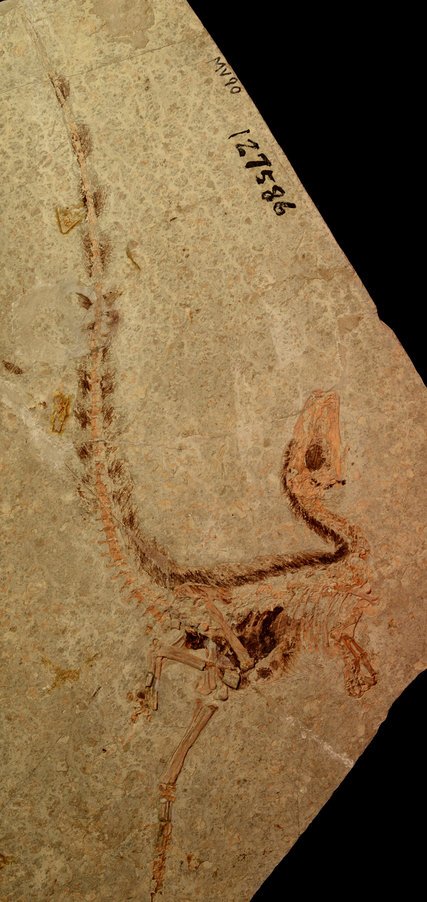A Turkey-Sized Dinosaur With a Raccoon-Like Bandit Mask

inosauropteryx first strutted onto the fossil scene in 1996. With its fuzzy feather coat, it revolutionized paleontology, suggesting that many dinosaurs had feathers.
Now the latest research on the extinct species offers a more vivid picture of its appearance: it sported a gingery-brown striped tail and a dark, bandit mask around its eyes — like a raccoon.
Paleontologists from the University of Bristol in England deciphered the dinosaur’s coloring by analyzing the preserved plumage from three Sinosauropteryx specimens. Their findings, published Thursday in the journal Current Biology, suggest that these roughly 126-million-year-old, turkey-sized carnivores may have had a camouflage pattern of dark colors on their backs that sharply changed to light colors near their belly.
This pattern is similar to that of modern animals living in open environments, like gazelles in the savanna or pronghorns on the Great Plains.
“It shows that the world of dinosaurs wasn’t so crazily far from what we could imagine today,” said Fiann Smithwick, a doctoral student at the University of Bristol and lead author of the study.
![27TB-BANDIT2-blog427.jpg]
( )
)
A couple of years ago, Mr. Smithwick’s adviser, Jakob Vinther, went to China and took high resolution images of Sinosauropteryx specimens under specially polarized light, which brought out their colors.
The dark feathers — the only ones that were preserved on the fossils — were filled with melanin, the same pigment that colors our hair and skin. It is a strong molecule that is resistant to decay and can survive in fossils for hundreds of millions of years.
Mr. Smithwick mapped the pigmented feathers on the fossils, finding that the Sinosauropteryx had brownish feathers covering its back and sides that stopped about halfway down its body. The rest of the feathers were most likely lightly colored.
The color pattern is a form of camouflage known as “countershading,” and on the Sinosauropteryx the transition from dark to light happened relatively high on the body. Mr. Smithwick said that the pattern could provide insight into the type of environment where the dinosaur lived.
He made 3D models of the dinosaur’s color shading and tested them under different types of light to see where they would perform best as camouflage. He found that the pattern was most useful in open environments where sunlight is coming straight from above with little interference.
When sunlight illuminates an animal’s top, it also keeps its underside in shadow, he said. This means that when something is looking at it, whether a predator or prey, the animal is seen as a three-dimensional object.
MORE REPORTING ON PALEONTOLOGY
Between a T. Rex’s Powerful Jaws, Bones of Its Prey ExplodedMAY 18, 2017
That Thing With Feathers Trapped in Amber? It Was a Dinosaur TailDEC. 08, 2016
First Fossilized Dinosaur Brain FoundOCT. 27, 2016
A Lost-and-Found Nomad Helps Solve the Mystery of a Swimming DinosaurSEP. 12, 2014
But countershading distorts the shadows in a way that makes the animal look less three-dimensional, and harder to spot. Animals that live in open, grassy environments have sharp transitions high on their body, from dark to light. But those that live in wooded or forested areas, like deer, tend to have a more gradual transition that appears much lower on the body.
The research suggests that countershading is not a modern evolutionary development, but a timeless camouflage technique.
Mr. Smithwick added that the dark feathers around the eyes indicate that Sinosauropteryx had “bandit masks,” most famously seen in raccoons, but also in some badgers, ferrets and red pandas.
Science Times
We’ll bring you stories that capture the wonders of the human body, nature and the cosmos.
Sign Up
SEE SAMPLE PRIVACY POLICY OPT OUT OR CONTACT US ANYTIME
Researchers tend to think mammals use the patches as warning signs that tell predators they are aggressive and not to be messed with. But Mr. Smithwick thinks Sinosauropteryx used its eye patches either as camouflage or to block glare, like athletes who paint dark stripes under their eyes to reduce incoming sunlight.
Steve Brusatte, a paleontologist at the University of Edinburgh in Scotland who was not involved in the study, said the research was a leap forward in paleontologists’ understanding of Sinosauropteryx.
“We knew before that its feathers were vibrantly patterned, but this study shows that it was countershaded and even striped,” Dr. Brusatte said in an email. “These findings breathe life into this dinosaur.”
Hi! I am a robot. I just upvoted you! I found similar content that readers might be interested in:
http://indascience.com/news/view/18954/dinosaur-raccoon-bandit-mask.html